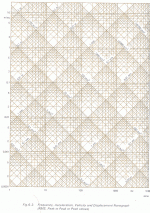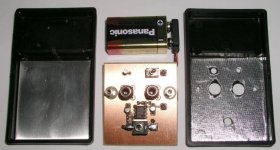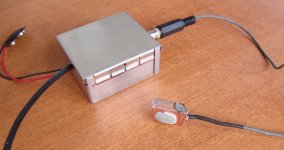What is the appropriate measurement range (in G) for measuring the vibration of enclosure panels?
I am thinking it would be very easy to use the output of an analog accelerometer as the "mic" input to Speaker Workshop. Since these accelerometers are not very expensive, I think it would be a great capability to have.
I am thinking it would be very easy to use the output of an analog accelerometer as the "mic" input to Speaker Workshop. Since these accelerometers are not very expensive, I think it would be a great capability to have.
First, I note that I just use an uncalibrated piece of PVDF- its low mass means that it won't perturb the measurement much and it has outstanding frequency response.
Second, if you have a feel for the max displacement and frequency, the g force is pretty easy to calculate. I can run through that if you don't know it already.
Second, if you have a feel for the max displacement and frequency, the g force is pretty easy to calculate. I can run through that if you don't know it already.
Unfortunately, I really have no idea how much the average panel moves in absolute terms, although I have a wealth of data from magazine reviews on the frequencies at which they tend to resonate. If you could just give me some idea, it would be most appreciated. I just want to know if we are talking 0-10G, 0-2G, or something much smaller.
I guess, I was thinking that 100G sensors are used on subs that have 1" or so of movement at 100Hz. I guess we need almost the same amount of dynamic range if the wall moves 1 mil at 3kHz. A big "if" thouhg since I have no idea. 
I did an experiment last night where I touched the measurement mic to the panel and did a MLS pulse. I found a peak in both the FR and the waterfall that seemed to correspond to the longitudinal resonance of the panel. It was interesting, but I have to assume this is a poor technique. There is no way to remove acoustic contamination, although the nearfield special case certainly applies. Perhaps a reasonable technique if done outdoors? Everything after the initial pulse should be resonance...
I did an experiment last night where I touched the measurement mic to the panel and did a MLS pulse. I found a peak in both the FR and the waterfall that seemed to correspond to the longitudinal resonance of the panel. It was interesting, but I have to assume this is a poor technique. There is no way to remove acoustic contamination, although the nearfield special case certainly applies. Perhaps a reasonable technique if done outdoors? Everything after the initial pulse should be resonance...
tiroth said:I am thinking it would be very easy to use the output of an analog accelerometer as the "mic" input to Speaker Workshop. Since these accelerometers are not very expensive, I think it would be a great capability to have. [/B]
Hi,
I'm now working on a couple of experiments with ACH 01 accelerometer. It is also very usable in panel vibration measurements.
You can find some application data at http://www.libinst.com/accel.htm
Regards,
Milan
Someone over on the Mad board was using an accelerometer from Digikey with good results.
http://dkc3.digikey.com/PDF/T051/1460.pdf
I think, but I'm not sure, it was the first one listed, ACH-01-03. The post has dropped out of the archives. Anyway, that looks like a good one with 2 Hz to 20 kHz response and 10mv/G sensitivity which should let you measure down to a small fraction of a G with most mic preamps. The max dynamic range is +/-150 G.
Edit: ah, I see that's the same one moamps is using.
http://dkc3.digikey.com/PDF/T051/1460.pdf
I think, but I'm not sure, it was the first one listed, ACH-01-03. The post has dropped out of the archives. Anyway, that looks like a good one with 2 Hz to 20 kHz response and 10mv/G sensitivity which should let you measure down to a small fraction of a G with most mic preamps. The max dynamic range is +/-150 G.
Edit: ah, I see that's the same one moamps is using.
I suggest an accelerometer somewhere in the 50G range. The goal should obviously be to use the accelerometer to document changes as you try different damping/stiffening techniques, so if you start "out of range" or clipping you know you've improved when you move into linear sensor territory. 
I also suggest starting with a simple tap test on the panel and a fourier transform analysis of the resulting impulse response. No need to input any sort of white noise signal with MLS techniques... a true impulse (or close enough for our goals) is easy enough in this case to generate by hand. Just a sharp blow with a hard object, measure, transform, and there is your resonant frequency.
That analysis will help identify appropriate stiffening and damping measures, and will tell you when you've moved the Fn and also when you've reduced its peak amplitude.
If you want to get more serious, I suggest displaying data in a shock spectra format (velocity vs. frequency) wiith G-level isolines running at angles. This type of data presentation is extremely helpful in directing efforts at problem areas.
I also suggest starting with a simple tap test on the panel and a fourier transform analysis of the resulting impulse response. No need to input any sort of white noise signal with MLS techniques... a true impulse (or close enough for our goals) is easy enough in this case to generate by hand. Just a sharp blow with a hard object, measure, transform, and there is your resonant frequency.
That analysis will help identify appropriate stiffening and damping measures, and will tell you when you've moved the Fn and also when you've reduced its peak amplitude.
If you want to get more serious, I suggest displaying data in a shock spectra format (velocity vs. frequency) wiith G-level isolines running at angles. This type of data presentation is extremely helpful in directing efforts at problem areas.
originally posted by tiroth
Unfortunately, I really have no idea how much the average panel moves in absolute terms, although I have a wealth of data from magazine reviews on the frequencies at which they tend to resonate. If you could just give me some idea, it would be most appreciated. I just want to know if we are talking 0-10G, 0-2G, or something much smaller.
Below attached a very nice conversion chart of frequency/ acceleration/ velocity/ displacement
scanned from the Brüel & Kjaer book "Piezoelectric Accelerometers and Vibration Preamplifiers"
a note to the graph:
acceleration is not nominated in g but in m/s^2
1g = 9,81 m/s^2
example:
a panel that displace 0,01mm at 1000Hz (I think this would be a more or less realistic value) is accelerated by (about) 400 m/s^2 = 41g
Attachments
Cool thread...
Very interested in seeing what kind of measurments you get, moamps!
I was interested in exploring in this area.. researched what was available at Digikey after remembering they had various accelerometers. I picked that one out BEFORE I found the LAUD article.. ;-) Guess I still know how to spec parts..
Havent had the time to buy one and play around though.. I have been using the very cheap and dirty method of a $5 mechanics stethoscope to listen to the panels as music is being played.. One can get a rough idea what and where it is "singing".
Kinda harder to quantify exactly how much difference changes make due to the subjective nature.. but again, you can get a rough idea..
Someday, I'll have to add the real deal to the toolkit...
Very interested in seeing what kind of measurments you get, moamps!
I was interested in exploring in this area.. researched what was available at Digikey after remembering they had various accelerometers. I picked that one out BEFORE I found the LAUD article.. ;-) Guess I still know how to spec parts..
Havent had the time to buy one and play around though.. I have been using the very cheap and dirty method of a $5 mechanics stethoscope to listen to the panels as music is being played.. One can get a rough idea what and where it is "singing".
Kinda harder to quantify exactly how much difference changes make due to the subjective nature.. but again, you can get a rough idea..
Someday, I'll have to add the real deal to the toolkit...
I've used the ACH-01 with Speaker Workshop with good results. Here's a sample of panel measurements:
http://ldsg.snippets.org/HORNS/images/random/cld.jpg
White was 3/4" MDF, and everything else was some sort of CLD construction, although I forget the exact details off hand. That is acceleration converted to dB (by SW). I never worry about trying to calibrate the system when I use it this way. It's all relative measurements. You just have to make sure what ever is doing the shaking is run at the same level for all measurements.
I've also used used this to measure cone excursion. I calibrated my preamp and then recorded the output from the accelerometer with a signal analyzer. This correlated very well with predictions from modeling programs. I've also used SW to do these measurements, but it was uncalibrated.
You can do quite a bit of stuff with these things considering that it only costs $20 or so.
http://ldsg.snippets.org/HORNS/images/random/cld.jpg
White was 3/4" MDF, and everything else was some sort of CLD construction, although I forget the exact details off hand. That is acceleration converted to dB (by SW). I never worry about trying to calibrate the system when I use it this way. It's all relative measurements. You just have to make sure what ever is doing the shaking is run at the same level for all measurements.
I've also used used this to measure cone excursion. I calibrated my preamp and then recorded the output from the accelerometer with a signal analyzer. This correlated very well with predictions from modeling programs. I've also used SW to do these measurements, but it was uncalibrated.
You can do quite a bit of stuff with these things considering that it only costs $20 or so.
This is quite an old thread but interesting...
I would like to know if there are some of you using accelerometers to measure enclosure vibrations.
The ACH-01 seems to fit this application. Are there other/better models now?
Would a microphone preamp work as the accelerometer amplification?
How do you mount the accelerometer onto the panel without damaging its finish ?
Let's bring this back up!
I would like to know if there are some of you using accelerometers to measure enclosure vibrations.
The ACH-01 seems to fit this application. Are there other/better models now?
Would a microphone preamp work as the accelerometer amplification?
How do you mount the accelerometer onto the panel without damaging its finish ?
Let's bring this back up!
I've been using an Analog Devices multi-axis accelerometer mounted on a breakout board that I got from Sparkfun.com. Not for speaker stuff, but you could get it in a higher max acceleration value if necessary. I was measuring acceleration on unfinished panels so can't really help with that.
Do you use an amplifier ?
What voltage do you use for V+?
Can you tell us more about your setup?
I don't know Praxis, I would use it with SE or Arta, connected to my sound card input (through a mic preamp if necessary).
I was thinking that it might be possible to use the phantom power of the mic preamp.
What voltage do you use for V+?
Can you tell us more about your setup?
I don't know Praxis, I would use it with SE or Arta, connected to my sound card input (through a mic preamp if necessary).
I was thinking that it might be possible to use the phantom power of the mic preamp.
For those who are interested, I found this.
The amplifier is now quite expensive (250US) so I might build the booster/buffer circuit described in the document.
I have a question for the electrnician experts:
on fig.3: is it one single IC drawn two times for clarity, or there are 2 ICs ?
The amplifier is now quite expensive (250US) so I might build the booster/buffer circuit described in the document.
I have a question for the electrnician experts:
on fig.3: is it one single IC drawn two times for clarity, or there are 2 ICs ?
- Status
- This old topic is closed. If you want to reopen this topic, contact a moderator using the "Report Post" button.
- Home
- Loudspeakers
- Multi-Way
- Panel vibration measurement (accelerometer)
 Thanks.
Thanks.

